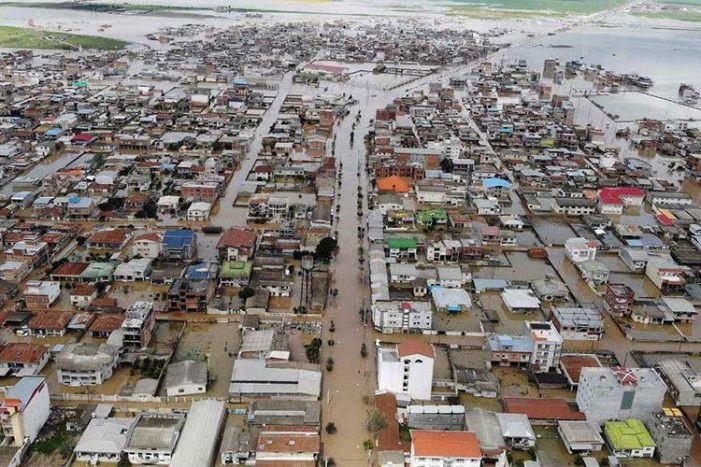
In March 2019 devastating floods ravaged Lorestan Province, stranding residents on rooftops, trees, and mountaintops for days waiting for government aid. The regime bungled the response to the floods, angering residents who were left homeless.
Floods swept through Iran once again in February, devastating provinces that were still reeling from the March 2019 floods. Almost a year later, little has been done to repair the crumbling roads and bridges in the affected provinces or take action to prevent another tragedy, despite promises from regime officials after the 2019 floods.
While the people of Sistan and Baluchestan freeze in treetops, the corrupt regime spends millions funding terrorist proxies in the regionhttps://t.co/NAGSkfeB62#Iran #floods #MEK @USAdarFarsi pic.twitter.com/xPyqhzu0G9
— MEK Iran (Mujahedin-e Khalq) (@MEK_Iran) January 26, 2020
March 2019 Floods
In March 2019 devastating floods ravaged Lorestan Province, stranding residents on rooftops, trees, and mountaintops for days waiting for government aid. The regime bungled the response to the floods, angering residents who were left homeless. The regime appointed the deeply unpopular Revolutionary Guards’ (IRGC) Khatam-al Anbiya Base to rebuild the areas damaged by the floods.
On March 8, 2019, the state-run Mehr News agency wrote: “Saeed Mohammad, Commander of the IRGC Khatam al-Anbiya Base, and Amir Ali Hajizadeh, Commander of the IRGC’s aerospace force, have been traveling to Majin Dareh Shahr in Ilam Province. During this visit, they were supposed to examine the latest situation of the flood-stricken people in Majin and their needs for building communication ways and new bridges.”
The director of Khuzestan’s Water and Power Organization also promised to take action to prevent a future disaster, declaring: “We are building flood dams 26 kilometers northwest of Ahvaz to prevent floodwaters of Karkheh and Dez.”
Broken Promises
In February 2020 the same cities were damaged from floods as in 2019. Poldokhtar, Mamoulan, Khorramabad, and Koohdasht all sustained heavy damages. Some of this destruction should have been mitigated by the promised repairs to neglected bridges and infrastructure that led to the bulk of the devastation in 2019. However, a closer look makes it clear that the IRGC constructed shoddy and unsafe bridges that were quickly destroyed in the floods and pocketed the profits.
On February 27, 2020, Meisam Ghadami, deputy of the Directorate General of Road Administration and Transport told the state-run Mehr news agency: “Regarding Davazdah Cheshmeh Bridge and five other bridges, I have to say that they were destroyed in the March floods, and due to the lack of funds needed for the construction of new bridges and to speed up traffic in the area, the Department of Roads and Transport temporarily installed metal deck bridges at the same location.”
Broken promises: On March 8, 2019, the state-run Mehr News agency wrote: “Saeed Mohammad, Commander of the IRGC Khatam al-Anbiya Base, and Amir Ali Hajizadeh, Commander of the IRGC’s aerospace force, have been traveling to Majin Dareh Shahr in Ilam Province. During this visit, they were supposed to examine the latest situation of the flood-stricken people in Majin and their needs for building communication ways and new bridges.”
The Davazdah Cheshmeh Bridge was a beautiful and historic bridge with cultural significance. It has stood since the 18th Century and was allowed to fall into disrepair under the mullahs’ regime due to their mismanagement and disrespect for Persian culture and history. The failure to restore it and provide a safe and sturdy bridge for the people of Lorestan is a further act of disrespect and corruption by the IRGC and the regime.
In the interview with Mehr, Ghadami described the damage caused by the floods, saying: “According to officials, [the floods caused] tens of billions of tomans in damages to urban and rural infrastructures, residential homes, the agricultural sector, etc., a huge amount of damage that has not yet been compensated. This happened again in February and this time too, the province suffered more than 2 billion tomans in damages. Now, despite the March losses, the February catastrophe is added to it.
The Regime Continues to Lie and Avoid Responsibility for #Flood Deaths https://t.co/7p9VPy3r6F#Iran #MEK
— MEK Iran (Mujahedin-e Khalq) (@MEK_Iran) April 5, 2019
“Damages piled up, promises of spring reached summer and were forgotten in autumn. Now in winter, the Lorestan flood victims are again in pain and suffering and the only thing to do is to hope that the flood will not hit Lorestan in the spring since until now the floods and rainfall have not woken up government officials,” he added.
During the floods, MEK members provided aid to flood victims when the regime failed to do so. In 2019 some MEK members were arrested for doing so. No government should punish its people for helping each other while simultaneously failing to provide basic assistance to citizens it has placed in harm’s way. This is one of the many reasons why Iranians are fighting for freedom and democracy.

